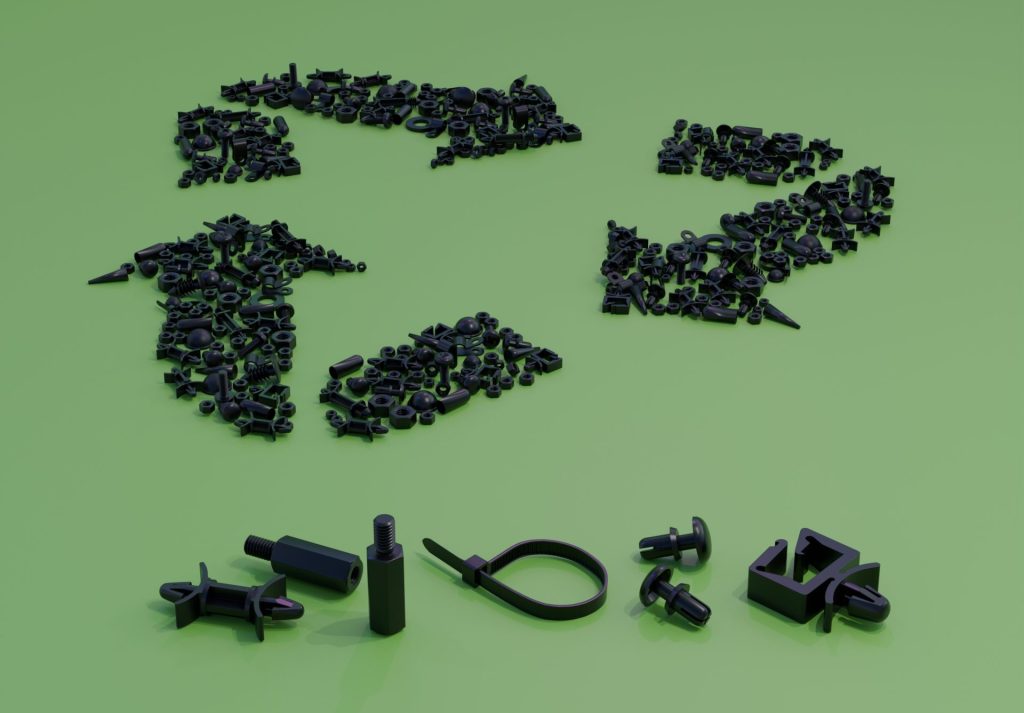For many businesses, making steps towards being greener and more sustainable is vital. This often concerns the big elements of their processes, packaging, materials and energy, but what about the smaller components that are used – what about the fasteners?
The Manufacturer spoke with Andrew Fletcher, Director of Plastics and Rubber at a global fastener manufacturer and distributor, TR, part of the Trifast plc Group, about its new 100% recycled nylon fasteners.
Can you walk us through the R&D journey behind this new range of 100% recycled nylon fasteners?
AF: We have reached a pivotal point in our research and development journey of the recycled nylon fasteners. We’ve now got a viable product and have begun the beta testing.
OEMs have been looking at sustainable products for several years, especially within automotive. We have seen seat manufacturers looking at bio-based leather and alternatives to large plastic parts have been looked at extensively.
Businesses want to increase the number of recyclable parts within a product and from talking and listening to OEMs, this is all part of their journey towards net zero. They are looking from the top down, focusing initially on large volume components and working their way down to the smaller parts.
I decided to get ahead of the game and investigate how TR can offer more sustainable options in the production of our plastic components. This includes products like small fastenings and fixings, clips, ties and cable management products, which are typically made from nylon or an acetal material.
I began by enquiring at material manufacturers to find out what they are doing about introducing recycled content into their materials. The results varied, some were using up to 30% recycled material but the impact on CO2 reduction was relatively small.
However, one manufacturer has been working and patenting a process using up to 100% recycled content from various feed stocks. The recycled materials come from fishing nets, fabrics, car airbag materials and many other sources. They receive this material, treat and scan it for any metal content. It is then cleaned, cut and reprocessed. This produces a nylon material that’s been processed to a controlled and consistent specification.
A potential challenge with this is that some manufacturers are cautious about using recycled plastics, as once they have been reprocessed, the material loses some mechanical performance. We needed to see how well it processed in our moulds and assess how well samples performed in comparison to virgin nylon parts.
You’ve reported up to a 90% reduction in CO₂ emissions compared to virgin-grade nylon. Can you explain what it means in terms of environmental impact across a typical product lifecycle?
We have not completed a full lifecycle analysis yet, but the emission reduction can already be seen from the production of the raw material to the point of it being moulded. A percentage of the emissions come from the refinement of the base materials derived from fossil fuels, whereas in the recycled product, that is no longer the case. This is the 90% reduction we can see in comparison to virgin materials.
As a manufacturer, that means processes begin with a lower number of emissions, especially on parts with a higher volume of material. If you’re looking to reduce your carbon footprint, using a recycled product represents a strong head start.
How do the recycled nylon fasteners compare with traditional counterparts in heat ageing, tensile strength or durability?
We conducted several tests on the recycled nylon fasteners, including push-in, pull-out and breaking tests and compared them. We haven’t yet conducted any long-term fatigue tests, but from the push-in and pull-out tests, we found them a little stiffer, but nothing that would cause long-term issues from an installation and performance point of view.
We then took those samples to a third-party company to heat-age them. They exposed the parts for 1,000 hours to 85°C to replicate them being held at a high working temperature. The mechanical tests were then repeated to establish if there was any drop off or degradation in the performance of those parts.
On the heat ageing side, we didn’t see any significant difference in performance. However, with regards to specification, tensile strength of the material was around 80% of the strength compared to a virgin material. It’s not as strong as the virgin material, but it is still within the safety factor of our products.
The challenge we have right now is the limited available choice of material grades, but over time the market will demand more of these materials and more will become available. We were only working with a limited selection. The other current challenge is colour. As the starting materials are various colours, the available product is black to cover all of this, so could be limiting for a custom order.

You’ve identified a gap in the sustainable plastics market for engineered fasteners. Can you discuss the shift in buyer behaviour toward greener components?
Outside of the recycled fasteners, the sector has seen packaging being driven by greener initiatives and the plastic tax. Some TR customers have requested that we look at reducing plastic in their packaging.
As mentioned, some OEMs have also asked us to look at their CO2 impact, including in the logistics and supply chain around the globe of materials and resources.
Beyond recycled nylon, what other sustainable material innovations is TR exploring? And where do you see the biggest opportunities for growth in green engineering over the next three to five years?
TRs main business is metal fasteners and the focus within that sector has been to increase the recycled content and the use of electric arc furnace production of steel, to reduce CO2 levels.
We also have a focus on removing single use plastics from packaging; however, they are often used for preserving items and increasing shelf life. It can be difficult to find an alternative for this.
From an application engineering perspective, TR focus on supporting with customer designs early on to help them reduce their environmental impact. We do this by improving and integrating fastener usage, which can lower material consumption, like enabling the use of thinner metal walls in cabinets and enclosures through specially designed fasteners.
We also encourage customers to think about their waste streams and choose jointing materials that support serviceability and recyclability. For example, instead of using adhesives that make products hard to disassemble and service, we suggest using mechanical fasteners. This way, products can be taken apart and repaired to help avoid unnecessary waste.
For more articles like visit, visit our Innovation channel.




